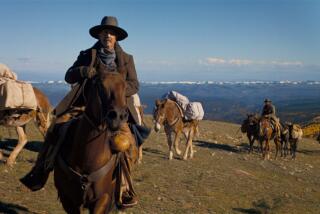Of Poetry, Sunrises and a Good Definition for Horizon
- Share via
That small children know quite well what horizon means was shown by the batch of definitions written by pupils of Joan Perkins’ fifth-grade class at Rancho Vista School in Rolling Hills Estates.
Their definitions were both plain and poetic, most identifying horizon with the sunset, perhaps because the children live near the sea.
My own definition (“The point where the Earth appears to end”) I dismissed as uninspired, or “not very poetic, but accurate.”
Reader John Degatina graciously disagrees. “Your definition,” he says, “is actually fraught with the poetry you deny. . . . The idea of the horizon being the point where the Earth appears to end touches me deeply. Judging by appearances usually misses the point altogether. That the Earth appears to end is an appearance, and (as we know from globes) not the reality at all. Similarly, it behooves us not to judge people and circumstances from their appearances, but rather to try and understand the reality beyond the appearance. I think your definition is excellent.”
Degatina’s analysis suggests that a thing may mean a great deal more to one person than it does to another. I can’t say that my definition was meant to contain such a truth, but if Degatina reads that into it, why not?
While the children’s definitions were charming, and true enough, I am pleased to hear from E.C. Krupp, director of Griffith Observatory, who may be regarded as an expert on horizons.
Krupp notes that the title I chose as an example of how the word horizon pervades our poetry and song (“Beyond the Blue Horizon”) is the title of his new book, “Beyond the Blue Horizon: Myths and Legends of the Sun, Moon, Stars and Planets “ (HarperCollins).
Krupp disagrees with my notion that the meeting of Earth and sky at a mountaintop is not a horizon; that a horizon must be flat.
“For traditional peoples, the horizon is, at least metaphorically, a point of contact with the sky. Although it is distant, it need not be flat.
“The original meaning for horizon is ‘boundary’ or ‘limit,’ ” he writes, “and our sense of territory, or bounded space, may owe something to the perception that the Earth ends at the ‘edge’ of the sky. As far as our eyes are concerned it does not matter if we know the Earth to be round or if we think it flat. At any particular spot we are surrounded by the rim of the horizon.”
It seems odd to me, though, to think of the place where a mountain meets the sky as a horizon. What if we are standing on a sidewalk below the towers of downtown Los Angeles? Would the place where the skyscrapers meet the sky be a horizon? The Earth does not seem to end up there, as it does at the point of a sunset. Wherever one stands, the Earth meets the sky. Yet one does not think of the spot on which one stands as the horizon.
Michael Scholl of Long Beach notes that if one stands on a beach, at sea level, the horizon is seven miles distant. He concedes that the exact distance depends on the height of the observer.
I don’t know what that proves except that we conceive of a horizon as that distant point where the Earth seems to meet the sky, thus ruling out the spot on which we stand.
Krupp makes a melancholy point about urban life. “Most of us have lost touch with the sky,” he says, “but we are reminded of our old heritage, now and then, when the colors of sunset recapture us and we stop and watch the last gleam of sun slip behind the dark silhouette of a distant horizon.
“Alarm clocks awake us now instead of the morning songs of the birds, but it is still possible to experience the sense of renewal our ancestors found in the dawn. All we have to do is rise before the sunup and wait for the first warm beams of light to spill over the landscape. By traveling outside our cities we can see the same stars people have watched for at least tens of thousands of years. . . .”
It’s true, I rarely look at the night sky, except now and then when a full moon rides over the freeway. But I happened to go into the back yard to get the dog one recent night and saw that spectacular display of crescent moon, Venus and Jupiter, all in line.
And a few years ago, while sojourning at our house in Baja, I saw Saturn and its rings through my telescope. It looked exactly as it does in the picture books.
By the way, Krupp reminds us: “Griffith Observatory has a stunning horizon and stages gorgeous sunrises and sunsets on a daily basis.”
Go, while the sun is still rising.
More to Read
Sign up for our Book Club newsletter
Get the latest news, events and more from the Los Angeles Times Book Club, and help us get L.A. reading and talking.
You may occasionally receive promotional content from the Los Angeles Times.









